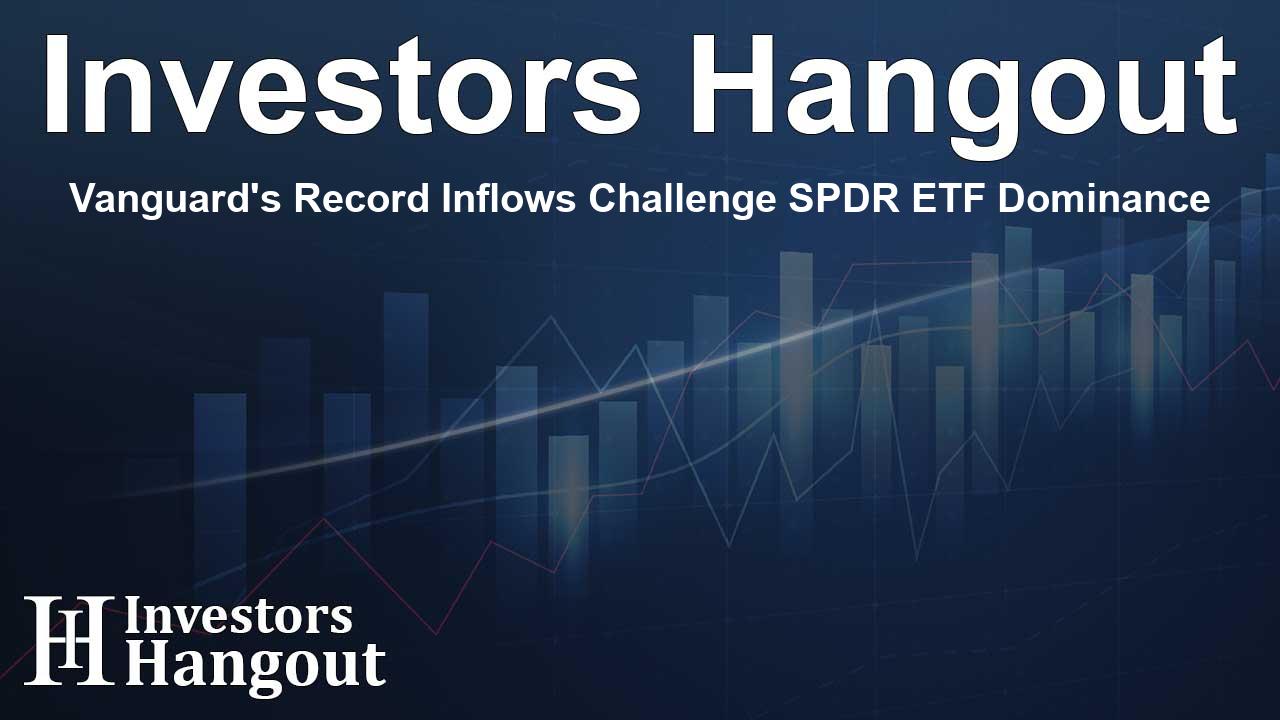Vanguard's Record Inflows Challenge SPDR ETF Dominance

Vanguard's S&P 500 ETF Surpasses $100 Billion in Inflows
The Vanguard S&P 500 ETF (VOO) has reached a historic milestone by surpassing $100 billion in annual inflows in a single year. This achievement marks a significant record for any exchange-traded fund (ETF) in such a timeframe, demonstrating a robust interest from investors.
Comparative Inflows: VOO vs. Competitors
Recent data indicates that VOO attracted $101.07 billion in new investments, outperforming its main competitors significantly. The iShares Core S&P 500 ETF (IVV) logged $59.2 billion, while the SPDR S&P 500 ETF Trust (SPY) garnered $22.9 billion.
The Implications for SPY's Dominance
In the competitive landscape of the ETF industry, this surge raises questions about the long-term dominance of SPY, the largest ETF to date. With an impressive AUM of $620 billion, SPY could be facing a potential challenge to its position.
Can VOO Overtake SPY?
Currently, VOO holds $579 billion in assets, considerably narrowing the gap between itself and SPY to just $41 billion. As the inflow trend continues, analysts speculate that VOO may soon dethrone SPY as the largest ETF globally. Sumit Roy, a senior analyst, noted the real possibility of this shift occurring in the near future.
Performance of Major ETFs
Here's a look at the ten largest ETFs by assets under management:
- SPDR S&P 500 ETF TRUST - AUM: $620.26 billion - Expense Ratio: 0.09%
- Vanguard S&P 500 ETF - AUM: $579.35 billion - Expense Ratio: 0.03%
- iShares Core S&P 500 ETF - AUM: $559.64 billion - Expense Ratio: 0.03%
- Vanguard Total Stock Market (VTI) - AUM: $460.11 billion - Expense Ratio: 0.03%
- Invesco QQQ Trust, Series 1 (QQQ) - AUM: $310.27 billion - Expense Ratio: 0.20%
- Vanguard Growth ETF (VUG) - AUM: $151.13 billion - Expense Ratio: 0.04%
- Vanguard FTSE Developed Markets ETF (VEA) - AUM: $135.42 billion - Expense Ratio: 0.06%
- Vanguard Value ETF (VTV) - AUM: $133.31 billion - Expense Ratio: 0.04%
- Vanguard Total Bond Market (BND) - AUM: $119.17 billion - Expense Ratio: 0.03%
Expense Ratios and Their Impact on Institutional Investors
One of the core reasons behind VOO's rising appeal is its extremely low expense ratio of 0.03%, which is considerably lower than SPY's 0.0945%. This difference can have significant ramifications, especially for institutional investors managing large funds.
For example, an individual retail investor contributing $5,000 to VOO would incur only $1.50 in annual fees. Conversely, the same amount invested in SPY would amount to about $4.73 in costs. While this may seem minor for individual investors, it becomes substantial for institutions.
Consider a scenario where an institutional investor channels $5 billion into VOO. Their fees would be just $1.5 million, compared to $4.73 million with SPY, illustrating a remarkable savings of $3.23 million. Such stark contrasts in fees can significantly impact capital flows into ETFs.
Conclusion: The Future of VOO and SPY
With Vanguard’s S&P 500 ETF making headlines for its remarkable inflows and lower costs, it’s clear that the dynamics of the ETF market are shifting. As institutional and retail investors consider their options, VOO’s competitive edge could redefine the landscape and challenge the long-standing position of SPY.
Frequently Asked Questions
What is the Vanguard S&P 500 ETF known for?
The Vanguard S&P 500 ETF (VOO) is known for its low expense ratio and significant inflows, marking it as a popular choice among investors.
How much did VOO attract in inflows this year?
In the current year, VOO attracted over $101 billion in new investments, setting a record for any ETF.
What are the assets under management for SPY?
SPY currently manages around $620 billion, making it the largest ETF but facing competition from VOO.
Why are expense ratios important for ETFs?
Expense ratios are important because they affect the net returns investors receive; lower ratios mean higher effective returns over time.
Can VOO overtake SPY as the largest ETF?
There is a real possibility that VOO could overtake SPY as the largest ETF, considering its rapid inflow growth and narrowed AUM gap.
About Investors Hangout
Investors Hangout is a leading online stock forum for financial discussion and learning, offering a wide range of free tools and resources. It draws in traders of all levels, who exchange market knowledge, investigate trading tactics, and keep an eye on industry developments in real time. Featuring financial articles, stock message boards, quotes, charts, company profiles, and live news updates. Through cooperative learning and a wealth of informational resources, it helps users from novices creating their first portfolios to experts honing their techniques. Join Investors Hangout today: https://investorshangout.com/
Disclaimer: The content of this article is solely for general informational purposes only; it does not represent legal, financial, or investment advice. Investors Hangout does not offer financial advice; the author is not a licensed financial advisor. Consult a qualified advisor before making any financial or investment decisions based on this article. The author's interpretation of publicly available data shapes the opinions presented here; as a result, they should not be taken as advice to purchase, sell, or hold any securities mentioned or any other investments. The author does not guarantee the accuracy, completeness, or timeliness of any material, providing it "as is." Information and market conditions may change; past performance is not indicative of future outcomes. If any of the material offered here is inaccurate, please contact us for corrections.